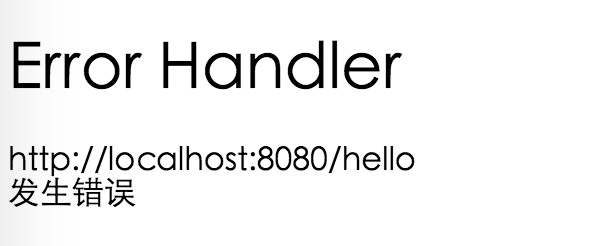我们在做Web应用的时候,请求处理过程中发生错误是非常常见的情况。Spring Boot提供了一个默认的映射:/error,当处理中抛出异常之后,会转到该请求中处理,并且该请求有一个全局的错误页面用来展示异常内容。
选择一个之前实现过的Web应用(Chapter3-1-2)为基础,启动该应用,访问一个不存在的URL,或是修改处理内容,直接抛出异常,如:
|
1
2
3
4
|
@RequestMapping("/hello")public String hello() throws Exception { throw new Exception("发生错误");} |
此时,可以看到类似下面的报错页面,该页面就是Spring Boot提供的默认error映射页面。
统一异常处理
虽然,Spring Boot中实现了默认的error映射,但是在实际应用中,上面你的错误页面对用户来说并不够友好,我们通常需要去实现我们自己的异常提示。
下面我们以之前的Web应用例子为基础(Chapter3-1-2),进行统一异常处理的改造。
- 创建全局异常处理类:通过使用
@ControllerAdvice定义统一的异常处理类,而不是在每个Controller中逐个定义。@ExceptionHandler用来定义函数针对的异常类型,最后将Exception对象和请求URL映射到error.html中123456789101112131415@ControllerAdviceclassGlobalExceptionHandler {publicstaticfinalString DEFAULT_ERROR_VIEW ="error";@ExceptionHandler(value = Exception.class)publicModelAndView defaultErrorHandler(HttpServletRequest req, Exception e)throwsException {ModelAndView mav =newModelAndView();mav.addObject("exception", e);mav.addObject("url", req.getRequestURL());mav.setViewName(DEFAULT_ERROR_VIEW);returnmav;}} - 实现
error.html页面展示:在templates目录下创建error.html,将请求的URL和Exception对象的message输出。123456789101112<!DOCTYPE html><html><head lang="en"><meta charset="UTF-8"/><title>统一异常处理</title></head><body><h1>Error Handler</h1><div th:text="${url}"></div><div th:text="${exception.message}"></div></body></html>启动该应用,访问:
http://localhost:8080/hello,可以看到如下错误提示页面。通过实现上述内容之后,我们只需要在
Controller中抛出Exception,当然我们可能会有多种不同的Exception。然后在@ControllerAdvice类中,根据抛出的具体Exception类型匹配@ExceptionHandler中配置的异常类型来匹配错误映射和处理。







【推荐】国内首个AI IDE,深度理解中文开发场景,立即下载体验Trae
【推荐】编程新体验,更懂你的AI,立即体验豆包MarsCode编程助手
【推荐】抖音旗下AI助手豆包,你的智能百科全书,全免费不限次数
【推荐】轻量又高性能的 SSH 工具 IShell:AI 加持,快人一步
· 从 HTTP 原因短语缺失研究 HTTP/2 和 HTTP/3 的设计差异
· AI与.NET技术实操系列:向量存储与相似性搜索在 .NET 中的实现
· 基于Microsoft.Extensions.AI核心库实现RAG应用
· Linux系列:如何用heaptrack跟踪.NET程序的非托管内存泄露
· 开发者必知的日志记录最佳实践
· winform 绘制太阳,地球,月球 运作规律
· 超详细:普通电脑也行Windows部署deepseek R1训练数据并当服务器共享给他人
· TypeScript + Deepseek 打造卜卦网站:技术与玄学的结合
· AI 智能体引爆开源社区「GitHub 热点速览」
· 写一个简单的SQL生成工具